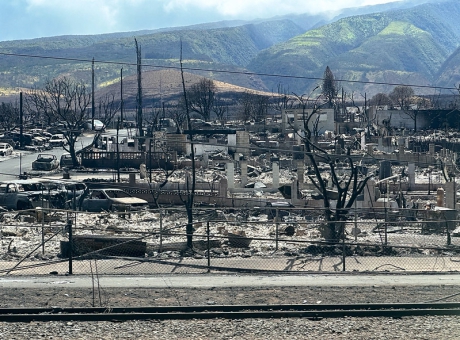News
You are here
Capitalism fanned the flames in Lahaina

August 23, 2023
On August 8 fire ripped through the town of Lahaina on the Hawaiian island of Maui. That evening over 2000 buildings were destroyed, almost all of them residences. So far the remains of over 100 people have been found in the ruins, but over a thousand people are still missing.
Identification of the dead is only possible by finger prints or DNA. Pictures of the destruction along Front St. show lines of cars destroyed where they were parked on the side of the road, left by workers and visitors who had no time to return to their car to try to escape. The town simply doesn’t exist anymore.
Lahaina fire at 10:25 PM August 8. NASA Earth Observatory image by Lauren Dauphin.
Fertile wetlands
The town of Lahaina has been home to Indigenous Hawaiians since time immemorial. Up until colonization it was the capital of the Hawaiian nation. The town was supplied by numerous canals bringing water from the slopes of the adjacent extinct volcano, Mauna Kahālāwai. This water supplied fish ponds for aquaculture and taro fields. Taro is a root vegetable grown in flooded fields like rice. As colonization proceeded Indigenous Hawaiian traditional culture was attacked. Many of the canals were filled in and the irrigated fields built over by colonists.
In the 1900’s the remaining canals were diverted to provide irrigation for sugar cane plantations surrounding Lahaina. In the late 1900s and early 2000s, the sugar companies decided it was no longer profitable to produce sugar on Maui and abandoned the fields. In the absence of irrigation and any management, invasive grasses took over the vast fields. The native forests and managed wetlands were much less susceptible to drought and trees, of course, create better wind breaks then grasses.
At the same time that these changes were made to protect profit, the climate continued changing. As in many places, droughts have plagued Hawai’i, and hurricanes around the world have increased in frequency and in severity over the last few decades.
On July 31 Hurricane Dora formed off the coast of El Salvador. It travelled out into the Pacific Ocean and is only the second hurricane ever to travel far enough to cross the international date line. Overall Hurricane Dora travelled more than 16,000 km, more than three times the distance from Victoria, BC to St. John’s, Newfoundland. As it passed south of the Hawaiian islands, a stronger than usual high pressure system moved north of the islands. The combination of the two pulled hot dry air across the island of Maui, down the slopes of the extinct volcano Mauna Kahālāwai and through the town of Lahaina. Winds gusted to over 100 km/hr. Once the fire started, perhaps due to sparks from the many downed power lines, the winds drove it through the town.
The fire that took so many homes and lives also took out the power and water for half of the island of Maui. The days after the fire saw a mass evacuation from all of West Maui. In addition to evacuating residents, 30,000 tourists were bussed to the airport to flee home. Two weeks later, water and power is slowly being restored to those areas. However, for much of that area the water is unsafe for any use. Residents are advised to only drink bottled water, and to only shower in warm water in a well ventilated area.
For many decades, the idea of a fire destroying a city seemed to be a relic of an older age. The scale and sophistication of our fire fighting techniques meant that we no longer had to worry about wildfires in cities. The Great Fire of London was in 1666. The Great Chicago Fire was in 1871. Between 600 and 1000 buildings were destroyed in the Great Vancouver Fire in 1886. There have been two great fires in Toronto. In 1849, several blocks of buildings around what is now the St. Lawrence market were destroyed. The much larger fire in 1904 destroyed over 100 buildings centred on Front and Bay Streets.
But mass fires that destory neighbourhoods or entire cities and towns are no longer just in our distant past. Accelerating climate change combined with land uses that have destroyed ecosystems for short term profit will keep creating these catastrophes. Only ending fossil fuel use, and massive rehabilitation of ecosystems combined with the Indigenous knowledge required to live in them, can save us. That will require a dedication of resources and changes to our methods of production that are impossible while defending profits. Either we destroy capitalism or we’ll all be taken down with it.
Section:










